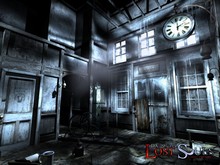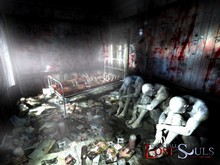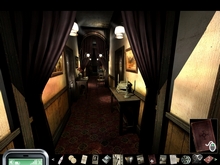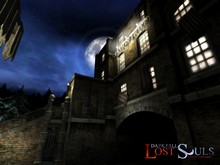- Interviews
- Jonathan Boakes (Erster Teil) (Englisch)
Interviews
Jonathan Boakes (Erster Teil) (Englisch)
Gesprächspartner: Ingmar Böke
Sprache: 
Vom:
09.04.2010
Über
Durch The Lost Crown und die Dark-Fall-Reihe machte sich der Entwickler Jonathan Boakes auch über die Indie-Szene hinaus einen Namen. Boakes ist der Kopf des im britischen Cornwall beheimateten Studios Darkling Room, welches er im Alleingang betreibt.
Adventure-Treff.de: Hello Jonathan, thanks for taking some time for us. Please introduce yourself and Darkling Room to our readers.
Jonathan Boakes: Hello there! My name is Jonathan Boakes; I am the writer and creator of the new supernatural thriller game, Dark Fall – Lost Souls. Some gamers may know me for my previous titles, Lights Out and The Lost Crown. I live in England, which inspires and informs much of my work.
A-T: Your creative output throughout the years doesen´t only include computer games, so please talk about your other fields of activity and your background aside of the game developer Jonathan Boakes.
Jonathan: I was always a photographer, before being a games designer, and still count myself as one. I love to photograph the world around me, and try to capture as much atmosphere and detail as possible. My first love was photography, back in the days before the digital SLR, so I spent a lot of time in ‘dark rooms’; developing shots in creepy, dimly lit, red hazed wonder. I think the experience stayed with me, as dimly lit rooms seem to appear a lot in my games!
With photography came graphic design, and typesetting, which is a world away from the arty side of production. It’s all technical, exact and very specific. I enjoy the ordered, hard quality that graphic design requires, and often create all of the box artwork for my games, which gets adapted by the publishers, and finally appears on shelves.
Lastly, I should mention that I am still a Club DJ, at weekends, playing Hard Floor and industrial techno to local, as well as city crowds. I like a lot of music, from folk to techno, so get to listen to all types of stuff. I guess that’s why the game soundtracks tend to be so mixed; in any one game you’ll hear old, scratchy gramophone recordings from the 19th Century, through to electronic experiments in tone and mood.

A-T: Guide us through your journey from “just” being an adventure game fan to creating games yourself and building a fanbase.
Jonathan: I was a fan of all games, rather than just adventure, but it was the virtual tourism aspect of adventure games that really impressed me. I loved the idea of creating virtual spaces, and adding layers of tone, texture and, of course, sound. With the right mix, and a bit of imagination, those early adventure games swept people away from their spare bedroom, or office, and away to exotic locations such as Egypt, Yucatán or the fictional worlds of Myst. It was an amazing experience, back then! I would meet with friends, in different places, but we would ship the PC to each venue, and sit and play Myst into the early hours, with lots of bottles of red wine! To us, they seemed like art, or very surreal films.
I had always wanted to create some form of interactive film, so I began to see games as the best way of delivering that experience. My first few experiments were encouraging, such as the photographically presented ‘The Displacement’ in 1999, so I took things more seriously, and learnt how to create new environments in CGI. The ability to create anywhere, any when, is a wonderful, but overwhelming experience. Where do you start? I kept things quite simple, re-creating a space I was already quite familiar with, so that I could focus on the detail, rather than battle with virtual engineering. Later I added the puzzles and elaborated on the story, but only after the location was finished. I think that is why the first game, Dark Fall, is so non-linear; I created the space, and then added the story to it. I think Dark Fall fans would probably say the ‘locations’ were the most interesting aspects of the games, so it makes sense to focus on them, and get them as right as possible.

A-T: Since you do most of the work on your games by yourself, you have a lot of freedom with getting things together. Let´s say a big publisher would approach you to do a game for them and would ask you to lead the development team, is this something, you would consider to do? Or is this thought just too far-off from your personal approach to game development?
Jonathan: I’d love to work in a larger team! My games take an age to create, as I often work on my own. This is not because I am isolated, creatively; it is because I don’t work on the games full-time. But, the right project, with the right team, would be a great experience. My games are often criticised for being a bit rough, or ‘independent’ in the production, which is inevitable when you are making games by yourself, and also funding the production yourself. A small team, of around 6 people, and some financial backing from a publisher could create a great adventure game.
I also think that a lot of ‘adventure’ games are still waiting to be made. I have a few notebooks full of complete ‘Game Documents’, which outline whole games, the characters, the puzzles, the sound, yet I know I will never have time to complete them! It is quite sad, in that way. With a small team, and a dedicated publisher, we would see my output increase by a huge amount. I don’t have to do everything myself!
Lastly, there are a lot of good TV shows and small films that would really benefit from having an ‘adventure game’ tie-in. The British dinosaur series, Primeval, would make an excellent game. Giant Slug Monsters in the Subway, Velociraptor’s in the shopping mall..etc etc. The premise of the show is simple; ancient dinosaurs invade our time, through portals, and a funky team must track them using gadgets, and send them (without violence) back to their own time. It’s no exactly Turok, but it would make a super adventure game. In terms of production, I would need a small team, some financial backing from a dedicated publisher, and the permission of the rights owners. I see myself creating larger titles, just like that. It would be so much fun, and would make a change from ghosts!

A-T: The German release of Dark Fall III: Lost Souls is right in front of the door. Please give our readers some info on the plot of your upcoming release.
Jonathan: It’s a psychological thriller, with a supernatural premise: Amy Haven went missing from the playground, in Dowerton, on her 11th Birthday. The police Inspector, who investigated the case, has never given up on finding out what really happened to Amy. You are the Inspector, and you follow his progress through the game, as you face up to ghosts from the past and your own sub-conscious.
Lost Souls is set very much in ‘our’ world, rather than the no-where places seen in a lot of popular adventure games. After producing The Lost Crown, which I think of as one of those ‘no-where’ games, I wanted to create something more contemporary, and ‘of the now’. I’ve been researching ‘Abandoned Places’ and ‘Urban Exploration’ websites; which have photos of derelict locations. There is a fascination to see the modern world crumbling, and loosing the fight against entropy. The images on the websites fed my imagination, so Lost Souls became an urban ghost story, as well as a thriller.
Perhaps I have always wanted to write a modern thriller, and ‘Lost Souls’ is the closest I have got. There are ‘real world’ threats, as well as supernatural ones, as you return to The Station Hotel and Train Station to solve a five year old mystery. The story is about what happens to a community when they have a hideous old ruin in the middle of their town, which has taken many people from their community, never to be seen again. There is a darkness that lives inside such places, hiding, waiting and watching. You, as The Inspector, make your way through the woods, to the derelict location, and start your search. The only way to complete this trial, and leave the place, is to communicate with the dead, understand why they are stuck in limbo, and help them move on, to ‘the otherside’.

A-T: In how far does the engine, which is used for the first time in a Dark Fall game, have an impact on the gameplay, opposed to the predecessors?
Jonathan: I am using the same engine as The Lost Crown, the wonderful ‘Wintermute Engine’, but we had to adapt what the engine can do (or shouldn’t do!) to create a game with full 360 turns for exploration. I wanted to keep the ‘slideshow’ feel of the first two Dark Fall games, but allow for more movement, and visual effects. This can only be done using 3D, so changes were made, and I am really thrilled with the end result. There is a lot more life, and movement, in the game; there is condensation from the player’s mouth, objects move on their own, light bulbs flicker and mist drifts around the feet of the player. It makes the whole adventure more realistic, and more exciting.
A-T: Speaking of the gameplay: What kind of puzzles and tasks can the players expect in general and how linear or non-linear is Dark Fall III?
Jonathan: The puzzles are a mix of ‘real-world, logic puzzles’ and surreal enigmas and tasks; it’s a good mixture. Some puzzles are quite straight forward, and traditional, others are bizarre, and nightmarish. There are also some randomised solutions, to allow re-play and prevent too much reliance on walkthroughs! None of the puzzles are too difficult, as all clues are present in the location, or you are told where to look. There are very few instances of pixel hunting, and two alternative endings. You will get a different ending, which will depend on you making an important decision. Your own, personal ‘moral compass’, and your views of ghosts, redemption and the soul will dictate the decision.
Lost Souls is a driven experience, rather than a completely non-linear experience. I used to love having complete freedom to make choices in adventure games, but have noticed that newer, and younger audience members get confused, and wonder ‘what to do’. This leads to boredom, and the game goes back on the shelf.

So, although you have large areas to explore in Lost Souls, you should not find yourself wondering ‘what am I doing?” as often as you do in older adventures. I think a thriller, especially a contemporary thriller, needs to be pushed forward, with a strong sense of pace. You will often get hints, and clues, throughout Lost Souls, from mysterious characters such as Echo; he/she is your friend, or so you think, and will lead you through the story to a frightening conclusion.
A-T: Lost Souls features different sorts of unpleasant creatures that the player is going to encounter, so a little creature-feature for our readers would be very welcome.
Jonathan: The ‘creatures’ are symbolic, and used in the story to represent various moods, states of mind and real-world threats. For example, one of the first creatures you will encounter are the unpleasant ‘Life Leeches’, these nasty creatures look a little like flesh worms, or harvested human organs. They are not nice to look at, and may upset some gamers, but please keep in mind that the creatures are symbolic of something, and must be destroyed to see what is really happening. In the case of the Life Leeches, they exist where there is human torment, and souls trapped in purgatory. The creatures survive by consuming the negative feeling, and energy generated by these sad ghosts; Life Leeches are a parasite. But, where there is a Life Leech, there is a trapped soul, so the nasty creatures have revealed someone in need of your help.
A-T: The importance of atmosphere and psychology has always been an important factor in your games. How would you describe the way that Lost Souls is trying to creep under people’s skin?
Jonathan: Great question! I like to think my games are more psychological, than gory, and Lost Souls is no exception. There is a little gore, here and there, but most of the threat is suggested, rather than broadcast, so gamers will have to decide if the world is really as bad as they are being shown or interpret.

The Station Hotel may have closed down, back in the 1940’s, but it never feels completely empty. There is a sensation of being followed, or watched, and the sound of the place suggests it is about to spring back into life! In fact, that does happen at several key points in the game. The rotten, derelict hotel transforms, back through time, to the past grandeur of the place, to feel how different the hotel was, all those years ago. You, the player, will get to see these ‘past versions’ of the hotel through the eyes of the guests who once stayed there. I can promise it is quite a surreal experience; to leave our time behind, and really ‘see’ the place as the ghosts of the past once did.
I think that is a very psychological way to present a game, so I hope the experience really does ‘creep under the skin’. Some gamers have emailed me to say that the game has started to invade their dreams; they are trapped in the past, waiting for someone to remember them, and pull them back into this time. In that sense, Lost Souls is quite an unusual ‘adventure game’, as the genre often celebrates harmless escapism, and casual gaming. Lost Souls is not a casual game, nor will it provide harmless escapism. It is a harsh game, set in a world haunted by its past. Nothing is quite what it seems.
A-T: Giving the player a permanent feeling of being in danger, seems to be one of the key elements of the game. In how far do the time critical sequences contribute to this element of psychological intimidation and what can you tell us about them?
Jonathan: Yes, I agree that there is a permanent feeling of danger, but only in the modern, contemporary setting. The past is a much more sedate era, and gamers will get to have a break from the threats seen in our time. Many people talk about the pace of life being ‘slower’ in the past, so it was something I was trying to capture, and include in the gameplay. It’s good to escape the horrors of modernity for a little while, before being plunged back into the dark urban nightmare. Modernity is given urgency through timed sequences, and puzzles in which you can fail. You do not ‘die’ as some reviewers have mentioned; no, instead, you retreat from the danger, and then have a second go! Or a third go! I think that makes some of the game more exciting than some ‘adventure games’ as you cannot always spend hours playing with the puzzles.

There is a ‘Hard’ and ‘Easy’ option, in Lost Souls too; so anyone who worries about ‘timed puzzles’ need not worry. The Easy setting really does make a difference, and adds lots of extra time. But, if you are quite used to action sequences, you will find the Hard setting the most satisfying, and thrilling.
A-T: Quite a long time has passed since you worked on Dark Fall I. Now you´re returning to the setting of the original Dark Fall game, The Journal. What was your motivation to come back to this place, after using a different setting in Dark Fall II: Lights Out, and in how far has this been a very personal journey for you, since I guess that not only Dowerton has changed since players have last visited it, but also your personal life, and you may not exactly be who you were when you were working on Dark Fall: The Journal.
Jonathan: Lost Souls is a dark, urban ghost story, and thriller; derelict locations lend themselves so well to these kinds of stories; abandoned buildings have a melancholy atmosphere, which prompts the urban explorer to wonder ‘how many people may have come and gone from these places’, and which stories remain untold? And, of course, what is the real truth behind haunted locations? Do ghosts exist? Or, do locations store the memories of those who were once there, but are now long gone? If the building falls, or is replaced, do those ghosts continue to haunt the place?
It is well known that traditional ghost stories tend to use classic locations, like castles to tell a spooky tale. This is based on the interpretation that older places would have more impressive ghosts. I have never believed that, myself. So, back in 2000, I wanted to do something different. Hotels and train stations have occasionally been used well in supernatural literature and film, with The Shining, and M.R.James ‘Room 13’ as obvious examples. I wanted to do something similar, but with an even more ‘urban’ feel.

A century ago Dowerton was a humble, isolated rural market town, with a small train station and hotel for passing commuters; it was loved by those who visited, and respected by those who lived and died there. Over the years the place has become engulfed by the suburbs, and the detritus of modernity, and lost the original rural identity that it celebrated. If that sounds too negative, then I must state that I enjoy exploring abandoned urban spaces, and looking for ghosts in locations which are not on the ‘classic’ ghost tours.
I am aware of what has happened to the rural world around me, these last two decades, but do not want to judge too harshly. There are many benefits to modern living, but that doesn’t stop both myself, and many gamers, feeling nostalgic for a past that never existed. In the UK, few would state that the world is a better place than 20 years ago, and Lost Souls recognises and illustrates that feeling. I guess I am a more cynical, and harder, writer than I was back in 2001, and would happily avoid many of the last few years, if I had been bestowed with the gift of hindsight.
Aktuelle Artikel
![]()
Unterstützen
![]()
Adventure-Treff-Verein
IBAN: DE38 8306 5408 0004 7212 25
BIC: GENODEF1SLR
Bitte beachtet, dass wir leider keine steuerrechtlich anrechenbare Spendenquittungen ausstellen können.
Mit jedem Einkauf bei unseren Partnern unterstützt ihr die Arbeit des Adventure-Treff e.V.













